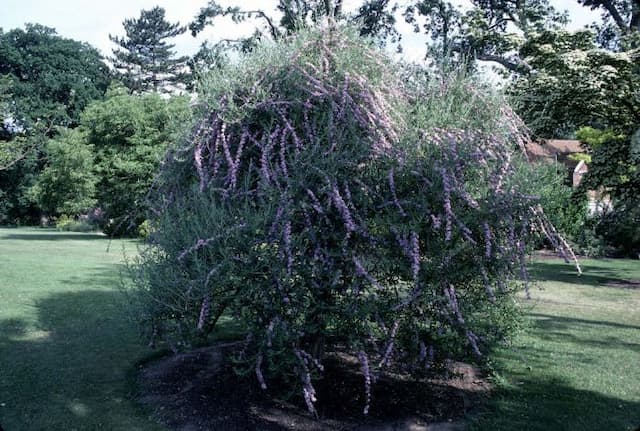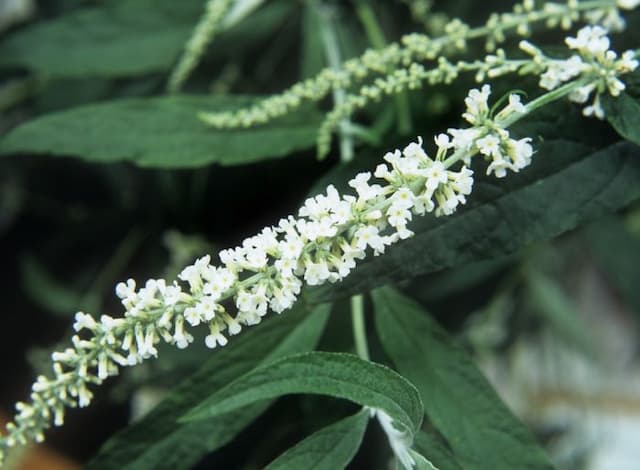Santana Butterfly Bush Buddleja davidii 'Santana' (v)

ABOUT
The Butterfly Bush 'Santana' is a visually striking plant known for its eye-catching foliage and flowers. The leaves of this plant are unique, displaying a variegated pattern with a mix of deep green centers and bright yellow to creamy white edges that create a striking contrast. This variegation adds a splash of color to gardens even when the plant is not in bloom. As for its flowers, 'Santana' produces long, conical clusters of blooms that can be a vibrant shade of purple or magenta. These flowers are densely packed on the flower spike and are known for their ability to attract butterflies, hence the common name Butterfly Bush. The blossoms have a delightfully sweet fragrance, which also draws in bees and other pollinators throughout the blooming period. The overall form of the Butterfly Bush 'Santana' is robust and bushy, with arching branches that give it a lush, rounded appearance. The plant has a natural grace, with its foliage and flowers softening the landscape and adding a sense of movement with their drooping habit. In sum, the Butterfly Bush 'Santana' is cherished by gardeners not only for its ornamental leaves and spectacular purple blooms but also for its role in supporting local wildlife, providing both visual appeal and ecological benefits to garden spaces.
About this plant
 Names
NamesFamily
Scrophulariaceae.
Synonyms
Santana Butterfly Bush, Santana Buddleia.
Common names
Buddleja davidii 'Santana' (v)
 Toxicity
ToxicityTo humans
Butterfly Bush (Buddleja davidii 'Santana') is not known to be toxic to humans. There are no significant symptoms of poisoning associated with this plant since it is generally considered non-toxic. Therefore, ingesting parts of the Butterfly Bush is unlikely to have serious consequences for human health.
To pets
Butterfly Bush (Buddleja davidii 'Santana') is also not known to be toxic to pets. It is generally considered safe, and there are no well-documented cases of poisoning in pets from ingesting this plant. Consequently, the consumption of Butterfly Bush by pets is not expected to cause harmful effects.
 Characteristics
CharacteristicsLife cycle
Perennials
Foliage type
Deciduous
Color of leaves
Variegated
Flower color
Purple
Height
6 feet (1.8 meters)
Spread
4 feet (1.2 meters)
Plant type
Shrub
Hardiness zones
5
Native area
China
Benefits
 General Benefits
General Benefits- Attracts Wildlife: Buddleja (Butterfly Bush) is known to attract butterflies, bees, and other beneficial insects to the garden.
- Ornamental Value: With its variegated leaves and vibrant flowers, Buddleja provides visual interest and aesthetic appeal.
- Drought Resistance: Once established, Buddleja is relatively drought-resistant, making it suitable for xeriscaping or low-water gardens.
- Rapid Growth: Buddleja can grow quickly, which makes it useful for gardeners looking to establish a feature or fill in gaps in a landscape.
- Easy Propagation: It is easy to propagate from cuttings, which is ideal for gardeners who wish to share plants or expand their own gardens without additional costs.
- Low Maintenance: Buddleja generally requires minimal maintenance, making it a good choice for gardeners of all skill levels.
- Privacy Screen: Due to its size and density, Buddleja can be used as a living privacy screen or hedge.
- Seasonal Interest: Its flowers bloom in summer and can last into autumn, providing extended seasonal interest in the garden.
 Medical Properties
Medical PropertiesThis plant is not used for medical purposes.
 Air-purifying Qualities
Air-purifying QualitiesThis plant is not specifically known for air purifying qualities.
 Other Uses
Other Uses- Buddleia 'Santana' can be used in mixed borders to provide a colorful backdrop for other plants due to its bright foliage and flowers.
- The plant's dense growth habits can be beneficial for providing shelter and habitat for wildlife in a garden setting.
- Its long flowering period makes it an excellent choice for adding interest to a garden throughout the summer months.
- Often planted in urban gardens, Buddleia 'Santana' can contribute to the green infrastructure and help in mitigating the urban heat island effect.
- In rural areas, it can be used in agroforestry systems as part of hedgerows or shelterbelts to protect crops from winds and erosion.
- The plant's rapid growth rate makes it suitable for use in educational projects where the lifecycle of a plant can be observed over a shorter period.
- Landscape artists and designers may use Buddleia 'Santana' as a living paintbrush to add splashes of color to large canvases of green spaces.
- The plant can be employed as a natural screen to hide unsightly areas of a garden or to provide privacy from neighbors.
- Buddleia 'Santana' wood is sometimes used in crafting for stakes or as part of decorative items due to the straightness of its stems.
- The vivid color and pleasant fragrance of the flowers can be utilized in sensory gardens, designed to be enjoyed through touch, sight, and smell.
Interesting Facts
 Feng Shui
Feng ShuiThe Butterfly Bush is not used in Feng Shui practice.
 Zodiac Sign Compitability
Zodiac Sign CompitabilityThe Butterfly Bush is not used in astrology practice.
 Plant Symbolism
Plant Symbolism- Transformation - Buddleja, commonly known as the Butterfly Bush, often symbolizes change and transformation due to its ability to attract butterflies that are themselves symbols of change.
- New Beginnings - As the Butterfly Bush is a favorite among fluttering butterflies, it represents new beginnings and the start of a journey, mirroring the life cycle of butterflies.
- Rebirth - The consistent blooming cycle of the Butterfly Bush can represent the idea of rebirth or new chapters in one’s life.
- Inspiration - Just as the Butterfly Bush inspires gardeners to create beautiful environments, it can signify a muse or a creative spark in one’s life.
- Attraction - The plant's ability to attract a variety of insects and birds, especially butterflies, symbolizes attraction and magnetism, perhaps in a person’s character or in a space that draws in positivity.
 Water
WaterThe Butterfly Bush should be watered deeply, ensuring that the soil is moistened thoroughly. It's essential to allow the soil to somewhat dry out between waterings. In general, watering once a week with about one to two gallons of water is sufficient for established plants, adjusting for rainfall. Increase frequency during prolonged dry spells or extreme heat. During the winter months, watering can be reduced significantly as the plant's water requirements decrease.
 Light
LightButterfly Bush thrives in full sun conditions, requiring at least six hours of direct sunlight per day. The plant will perform best and bloom most prolifically if placed in a location that receives unfiltered sunlight for the majority of the day. While it can tolerate some light shade, too much shade can lead to reduced flowering and a leggy growth habit.
 Temperature
TemperatureButterfly Bush is hardy and can tolerate a wide range of temperatures; however, it prefers a mild to warm climate. They perform best in temperatures ranging from 60°F to 90°F. The plant can survive minimum temperatures down to around -20°F and maximum temperatures as high as 100°F, but for optimal growth, staying within the ideal range is encouraged.
 Pruning
PruningPruning a Butterfly Bush is important to encourage new growth and abundant flowering. Prune in late winter or early spring before new growth begins, cutting back the previous year's growth to about one foot from the ground. This practice also helps maintain an attractive shape and prevents the plant from becoming too leggy or woody. Deadheading spent blooms may encourage additional flowering.
 Cleaning
CleaningAs needed
 Soil
SoilButterfly Bush 'Santana' thrives in well-draining soil enriched with compost or peat moss. It prefers slightly alkaline to neutral pH levels, around 6.5 to 7.5. A mix of two parts garden soil, one part well-rotted compost, and one part coarse sand or perlite is ideal to ensure proper drainage and fertility.
 Repotting
RepottingButterfly Bush 'Santana' should be repotted approximately every 2-3 years or when it is evident that the plant has outgrown its current pot. This will provide fresh nutrients and encourage continued growth.
 Humidity & Misting
Humidity & MistingButterfly Bush 'Santana' is tolerant of a wide range of humidity levels and does not have specific humidity requirements. It grows well in outdoor conditions where it can thrive in the ambient humidity.
 Suitable locations
Suitable locationsIndoor
Provide full sun, well-draining soil, and water when dry.
Outdoor
Plant in full sun, use well-draining soil, and water regularly.
Hardiness zone
5-9 USDA
 Life cycle
Life cycleButterfly Bush 'Santana' (Buddleja davidii 'Santana') typically begins its life cycle as a dormant seed which, when exposed to optimal conditions of warmth and humidity, will germinate and sprout. The seedling then develops into a young plant, which will establish a root system and begin to produce its distinctive foliage, characterized by variegated leaves with yellow margins and green centers. As the plant matures, it enters a rapid vegetative growth phase, during which it develops its woody structure and branches out. Following this, 'Santana' enters the flowering stage, usually in mid to late summer, where it produces cone-shaped clusters of fragrant purple flowers that attract butterflies and other pollinators. After the blooming period, the flowers fade and are replaced by small seed capsules that, when matured, release seeds for the next generation. With the arrival of colder temperatures, the plant enters a period of dormancy, conserving energy for the next growing season.
 Propogation
PropogationPropogation time
Spring to Summer
Propogation: Buddleja davidii 'Santana', commonly known as the Butterfly Bush 'Santana', is typically propagated through semi-hardwood cuttings. The best time for taking cuttings is during the summer months when the plant is actively growing and the new stems are semi-ripe. Cuttings should be about 4 to 6 inches (approximately 10 to 15 centimeters) long, taken from healthy, disease-free plants. Leaves on the lower half should be removed and the cut end dipped in rooting hormone to encourage root growth. The cuttings are then inserted into a well-draining potting mix or a sandy soil mixture, ensuring the bottom leaf nodes are buried. To maintain a high humidity environment, which is crucial for root development, a plastic bag or cover can be placed over the pot, being careful not to let the plastic touch the leaves. Keeping the soil consistently moist but not waterlogged, roots typically form in four to eight weeks, after which the new plants can be gradually acclimated to outdoor conditions.




![Butterfly bush [Florence]](/_next/image?url=https%3A%2F%2Fplants-admin.emdemapps.com%2Fimages%2Fplants%2F%2Fimages%2F604b5f52d7bb1.png&w=640&q=75)




